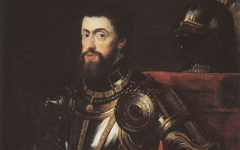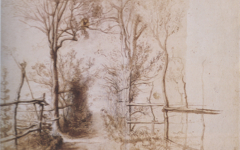Rubens’ Miracles of St. Ignatius of Loyola (c.1619)

Rubens, The Miracles of St. Ignatius Loyola (c.1619) Oil on panel. Dulwich Picture Gallery, London
Click image to enlarge.
The conventional way to comment on this picture of St Ignatius performing miracles is probably to praise Rubens' brushwork and then note the spiritual values, whatever they refer to, that he conveys. Not only does that sound a bit boring but wouldn't it have been boring for Rubens too? A better starting-point, I think, and a more interesting one is to ask: how could this depict Rubens' own mind at the moment he conceived the picture?
Click next thumbnail to continue
Once you know how great art is made, some features, never seen before, are unmissable. Take, for instance, Rubens' face staring out of the left-hand side of this detail.
Click next thumbnail to continue

Top L: Detail of Rubens' The Miracles of St. Ignatius Loyola
Top R: Rubens' Self-portrait (c.1623), inverted, rotated and slanted
Bottom: Diagram of the detail above
Click image to enlarge.
Compare the detail to Rubens' Self-portrait from a few years later and then look at the red lines in the diagram below.1 His open "eye" is formed by a woman's arm and hair, thereby linking craft (arm) and vision (eye), the hair which she holds referring to the hairs of a paintbrush. The other "eye" at the base of the column is closed for insight. Open and closed eyes are a common theme in art.2 The sleeve of the man's green jacket is Rubens' "nose" with a characteristically flat end to it. See it in the self-portrait too. His downturned "mouth" is in the blue below while his extravagant "moustache" is appropriately formed from hair. The blue of the man's thigh suggests his raised beard.
Click next thumbnail to continue
The man in the center of Rubens' "face" is clothed green for fertility and has blond hair like Rubens himself. He looks angelic. His circular head, above and between the two "eyes" (left), stands either for the inner eye in Rubens' mind and/or Rubens' intellect. Out of it, whichever it may represent, emerges the principal figure of the saint performing miracles.
Click next thumbnail to continue
The saint stretches his open palm not towards the adoring spectators below but to Rubens himself, perhaps, outside the picture at eye level. What amazes the spectators, then, is not his actual miracle but the miracle of Rubens' painting. The saint's outstretched hand is that of the divine artist painting, I believe, what we see. He is Rubens' imagined reflection in the mirror of his mind. In between the people and the saint is the mirror's invisible surface that he touches, separating him, the creator, from the viewers outside the painting. Yet, since most see it without imagining the division, the two parts, artist and painting, merge just as Edouard Manet was later to merge the artists and the painting in Le Déjeuner sur l'Herbe.3
There must, of course, be more to this picture and I myself have only just begun to look at it. Nevertheless this approach should help viewers to further unseen insights in ways that a conventional view of art rarely will.
More Works by Rubens
Notes:
1. I have inverted, rotated and slanted Rubens' Self-portrait to demonstrate how the veiled face should be imagined. Anamorphosis, or distorted perspective, is a common feature of hidden images in part because they are mental images which are always imagined to be fractured, distorted or bent out of shape.
2. See the theme Insight-Outsight.
3. See Abrahams, Manet's Le Déjeuner sur l'Herbe (1863).
Original Publication Date on EPPH: 20 May 2013. © Simon Abrahams. Articles on this site are the copyright of Simon Abrahams. To use copyrighted material in print or other media for purposes beyond 'fair use', you must obtain permission from the copyright owner. Websites may link to this page without permission (please do) but may not reproduce the material on their own site without crediting Simon Abrahams and EPPH.





